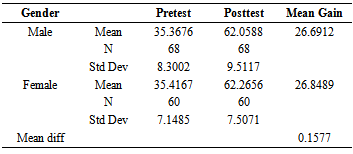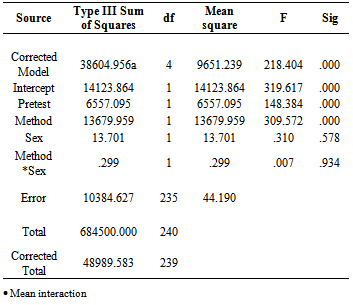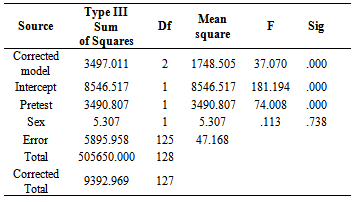-
Paper Information
- Next Paper
- Paper Submission
-
Journal Information
- About This Journal
- Editorial Board
- Current Issue
- Archive
- Author Guidelines
- Contact Us
Education
p-ISSN: 2162-9463 e-ISSN: 2162-8467
2014; 4(1): 7-11
doi:10.5923/j.edu.20140401.02
An Examination of the Facilitative Effect of the Computer Assisted Instruction (CAI) in Students’ Achievement in Chemical Reaction and Equilibrium
Emmanuel E. Achor1, Joel O. Ukwuru2
1Department of Curriculum and Teaching, Benue State University, Makurdi, Nigeria
2Department of Chemistry, College of Education, Oju, Benue State Nigeria
Correspondence to: Emmanuel E. Achor, Department of Curriculum and Teaching, Benue State University, Makurdi, Nigeria.
| Email: |  |
Copyright © 2012 Scientific & Academic Publishing. All Rights Reserved.
This study is an examination of the effect of the Computer Assisted Instruction (CAI) on senior secondary school students’ achievement in chemical reaction and equilibrium. The study employs a pretest, posttest non-randomized control group design. The sample size of the study comprises of 128 male and 112 female students (n =240). Simple random sampling was used to assign intact classes to experimental and control groups, while purposive sampling was used to select 10 public senior secondary schools in Oju LGA of Benue State. The instrument used for the study is the Chemical Reaction and Equilibrium Achievement Test (CREAT). The students’ scores from CREAT were collected and analyzed using mean and standard deviation to answer the research questions and ANCOVA was used to analyse data for testing the hypotheses at 0.05 level of significance. The result showed that there is a significant difference between the mean achievement of students taught chemical reaction and equilibrium using CAI and those taught same using conventional strategy (F1, 239 =309.572;P=0.000< 0.05). Conversely, there is no significant difference in mean achievement between male and female students taught chemical reaction and equilibrium using CAI strategy (F1, 127=113; p=.733> 0.05). Based on the findings, the study recommends that, government should increase funding for the entire educational sector in order to procure reasonable number of computers and its software like CAI for senior secondary school to enhance teaching and learning with CAI strategy to aid achievement in chemistry.
Keywords: CAI, Chemistry achievement, Chemical reaction and equilibrium, Chemistry teaching, Gender
Cite this paper: Emmanuel E. Achor, Joel O. Ukwuru, An Examination of the Facilitative Effect of the Computer Assisted Instruction (CAI) in Students’ Achievement in Chemical Reaction and Equilibrium, Education, Vol. 4 No. 1, 2014, pp. 7-11. doi: 10.5923/j.edu.20140401.02.
Article Outline
1. Introduction
- Observation over the years is that students’ achievement in chemistry at Senior Secondary School level (SSCE) has not been very encouraging. According to WAEC[1], candidates that offered chemistry performed poorly in the areas of understanding of the concepts of equilibrium of reversible reaction, writing of formulae and correct balanced chemical equations as well as explanation of basic chemical principles, concepts and their applications. Chemistry is one of the subjects in which the students’ achievement at the SSCE level has remained persistently low in recent time[2]. The poor performance of students in chemistry at SSCE is attributed to a number of factors ranging from teachers’ attitude, the learners’ attitude, and the curriculum, method of instruction and instructional materials, mathematical deficiency among others[1]. The problem of underachievement in chemistry is of great concern to the government, parents, chemistry teachers and researchers in chemistry and several attempts have been made to tackle the problem. These attempts focused more on methods adopted for teaching. For instance, Masek and Yamin[3] found that students’ critical thinking ability in the problem based learning (PBL) group had not been significantly different from their counterparts in the conventional approach group, an indication that most of the so called innovative strategies have not given us the needed result. Though tried with other science subjects, the use of the Computer Assisted Instruction (CAI) is not common in chemistry especially at the SSCE level which is the focus of this study. The Computer is an electronic device used for executing precisely stated rules with accuracy, rapidity and with real reliability. According to Eriba in Unongo[4], computer is capable of making calculation, storing information in various fields of study, designing devices, and making graphical representation of engineering parts and providing leisure in form of music. Studies have shown that computer self-efficacy has a positive effect on information literacy self-efficacy. Tuncer,[5] and Geban, Askar, and Ozkan[6] as well as Inci, John, Nilgun and Ozge[7] and Mudasiru and Adedeji[8] all found the use of the computer in teaching to facilitate achievement in chemistry and other sciences. However, integration of ICT into education system in Nigeria is poor[9].Adoption of CAI as teaching strategy is one prominent aspect of use of ICT worldwide. In classroom, CAI holds the promise of carrying the learners along as well as making them active rather than passive participants especially in the sciences. The fact that CAI could be prepared to meet target presupposes that it is adaptable which renders its usage wide acceptance.Also related to achievement in chemistry is the gender issue. Result from research findings have revealed that male students perform better than the females in physics, chemistry and biology generally[10] while Agwagah as cited by Olom[11] revealed significant difference in achievement in favour of the females. Researcher such as Aiyedun[12] found no significant difference in the performance of boys and girls in mathematics. What appears not to be very clear is whether these performances vary with method of instruction. Thus there may be need to try use of the CAI so as to be well informed of the achievement of male and female students. The purpose of the study therefore was to investigate the effect of the CAI on students’ achievement in senior secondary chemical reaction and equilibrium in Oju LGA of Benue State of Nigeria.
2. Theoretical Basis for the Study
- According to Skinner[13], nearly all identifiable human behaviours fall into two categories namely; respondent and operant behaviours. Respondents’ behaviours are involuntary (reflex) behaviours and result from special environmental stimuli. Skinner further posits that in order for behaviour to occur, it is first necessary that a stimulus be applied to the organism. Only a few of human behaviours are respondent behaviours.Appropriately, computer based instruction can be applied as a stimulus to the students’ responses of interest, motivation and consequent achievement in chemistry learning. In the same vein, the design of computer based instruction programme makes immediate feedback as response to the chemistry student to stimulate him or her to generate commitment to the learning using his or her present status as a basis. This Skinner stimulus-response and the response-stimuli theory provide a strong framework for computer based instruction innovation.In the computer facilitated learning, students’ behaviours are reinforced by being permitted to proceed to the next frame when they get the right answer[14]. Ogunz[15] indicates that skinner illustrated how to develop programmed learning sequence which is being used directly to design tutorial modules. According to Owusu in Ogunz[15], the use of the CAI especially in tutorial mode is supported mostly by the behaviourist view of learning. This is due to the principle of practice and reinforcement. Therefore, the developers of tutorials mostly incorporate this theory of learning in their programme. Working on the computer compares with working in the laboratory and the mere regular attendance in the laboratory is found to assist learning[16, 17, 18]); this suggests that CAI could be probably be self motivating.
3. Research Questions
- The following research questions guided the researcher in this study;1. To what extent does the use of CAI in teaching chemical reaction and equilibrium improve students’ achievement as against the use of conventional method?2. What is the achievement of male and female students who are exposed to CAI method in chemical reaction and equilibrium?
4. Hypotheses
- Based on the purpose of the study the following null hypotheses were tested at 0.05 level of significance. 1. There is no significant difference in the mean achievement scores between students taught chemical reaction and equilibrium using conventional method and those taught using CAI. 2. There is no significant difference in the mean achievement scores of male and female students taught chemical reaction and equilibrium using CAI strategy.
5. Methodology
- A quasi-experimental design was employed for the study. Specifically, the non-randomized control group, pretest, post -test design was adopted for the study. A total of 240 senior secondary (SS) 2 students were drawn from 10 public schools in Oju Local Government Area of Benue State. This comprises of 127 male and 113 female students. The number of students taught chemical reaction and equilibrium were made of 128 students that consist of 68 male and 60 female students and112 students were taught using conventional strategy.The sampling was concluded by random sampling of 4 intact classes from 4 schools that have computer facilities out of the 10. Similarly, by random sampling 2 classes were assigned to experimental group and the other 2 to control group. Accordingly, the respective biology teachers in each of the schools who were previously trained and ascertained to meet the selection criteria were used. Thus a total of 4 graduate biology teachers (2 in each study group) were engaged.A 20 items multiple choice questions constructed by the researchers were patterned after West African Examination Council (WAEC) Senior School Certificate Examination Chemistry paper 2 called Chemical Reaction and Equilibrium Achievement Test (CREAT). It was validated by two experts from the department of curriculum and teaching Benue State University, Makurdi. They were requested to do face, content and construct validity. Their comments further improved the quality of the instrument. From the trial testing the reliability of the instrument was determined using the Kuder-Richarson formula 21 (K-R21) and was found to be 0.70. Thus the instrument was considered good for use based on literature. The students in experimental and control groups were both exposed to Chemical Reaction and Equilibrium Achievement Test (CREAT) as pretest. The control group students were taught using the conventional strategy while the experimental group was taught using CAI strategy. The treatment for all the groups lasted for six weeks. Each group had equal contact hours (2hrs 40 minutes per week) with the students. While it took longer time to teach the CAI group because of its individualized nature, the control group used the same time but spread into teaching, interaction time and drawing summary of each lesson. After the treatment, the two groups were exposed to the CREAT which has been reshuffled as posttest. The mean and standard deviation were used to answer the research questions while data for the hypotheses were analysed using the Analysis of Covariance (ANCOVA) and testing done at 0.05 level of significance.The CAI was developed jointly by two experienced biology teachers and a computer expert reflecting relevant contents of chemical reaction and equilibrium. It was made interactive such that the learners could be engaged in dialogue and feedbacks provided immediately to enable learners proceed. Details are available for consultation on request.
6. Results
- Research question 1:Data relevant to the research question one are presented in Table 1.
|
|
|
|
7. Discussion
- Achievement of students taught chemical reaction and equilibrium using CAI is significantly higher than those students taught same with conventional strategy. This shows that the use of CAI in teaching chemical reaction and equilibrium can improve students’ achievement. This finding agrees with the findings of Geban, Askar, and Ozkan[6] and that of Inci, John, Nilgun and Ozge[7] which are directly on chemistry. Similarly, the finding agrees with the studies of Mudasiru and Adedeji[8] in biology, thus establishing that the CAI is effective in enhancing students’ achievement in chemical reaction and equilibrium in chemistry in similar manner as found by the afore mentioned authors in chemistry and biology from previous studies. It could be explained that the use of CAI as emphasized in the theoretical frame work engages learners, makes them active participants and alert as well as motivates or enhances their interest through constant feedback mechanism. Feedback as noticed in this study could have served as link, how to follow instruction as well as an eye opening to where they must have missed the link or instruction. Thus it was possible for students to improve in their achievement since it acted like a reinforcer and source of stimulation. In similar manner like other innovative student centered methods, students do not only listen but were involved in doing and thinking which are found to aid remembrance and retention. Thus the finding in this study is seen as commensurate with the efforts put in to actively engage learners.Though the use of CAI might not have been the only variable that must have influenced achievement in this study, the effects of all other variables were to some extent held constant (that is, applicable to both control and experimental groups). Thus, teachers of same qualification and same experience were engaged, initial difference in learners was taken care of by using ANCOVA in data analysis to remove the starting difference. Also, the use of intact classes was expected to neutralize the differences in abilities of learners. Thus it was assumed that Hawthorne Effect was taken care of in the study.The study revealed that gender has no significant effect on the achievement of students in chemical reaction and equilibrium when taught with CAI strategy. This finding on gender agrees with the earlier findings of Mudasiru and Adedeji[8], Husaini and Mohammed[17] on gender. Thus it can be said that the use of CAI method enhanced the achievement of both male and female students similarly in chemical reaction and equilibrium. The implication of this finding could be that what matters in teaching and learning is the effectiveness of the instructional strategy. Accordingly, once an instructional strategy is motivating and engages students’ attention, it does not discriminate in the performance of males and females. The corollary could be that where male and female students’ achievement differs after teaching, the interactive nature of the method should be questioned.
8. Conclusions and Recommendations
- The use of the CAI in teaching chemistry concepts facilitated the achievement of students in chemical reaction and equilibrium better than the use of conventional strategy. The gender difference among students exposed to CAI was not significant implying that CAI is capable facilitating learning in similar manner among male and female students in chemical reaction and equilibrium.It is recommended therefore that:1. Computer literacy and operation in the secondary schools should be encouraged while relevant CAI packages should be accorded attention and developed for use within the Nigeria school system. This can be done by bringing experts in biology and computer together to design something in line with the senior secondary curriculum.2. Educational curriculum planners should endeavour to integrate a practical computer application course in their curriculum design for pre service teachers. This will enable them to use computer to teach chemistry and other science subjects effectively.
 Abstract
Abstract Reference
Reference Full-Text PDF
Full-Text PDF Full-text HTML
Full-text HTML


